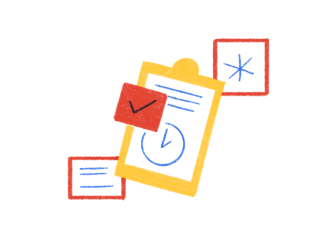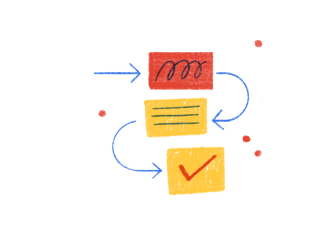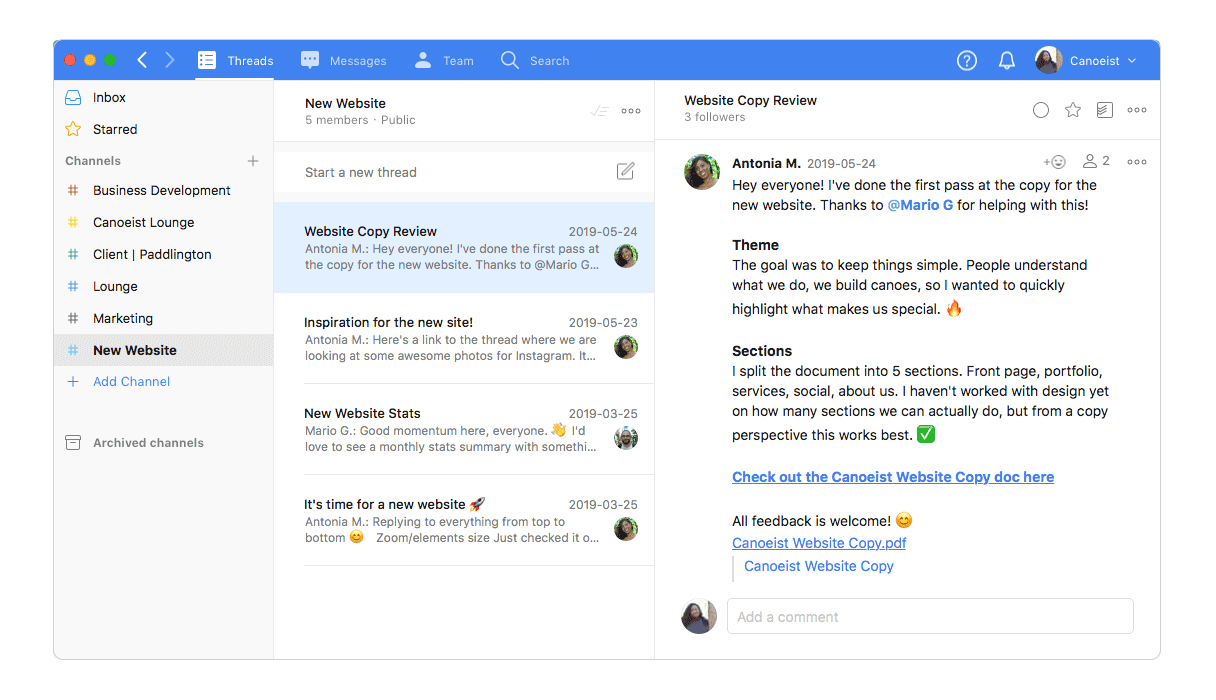Remote work is here to stay.
Flexible schedules, the freedom to work from anywhere, more time to spend with friends and family—it's no wonder 99% of remote workers say they'd like to work remotely at least some of the time for the rest of their careers.
It isn't just remote employees who reap the benefits, either. Companies embracing remote work see higher productivity, less time wasted, and reduced overhead costs.
Yes, remote work can be great, but it also brings an entirely new set of challenges. High-quality projects still need to be delivered on schedule, but coordinating work is difficult when teammates are spread across the world. Teams can't cram into a conference room, but they still need ways of collaborating in real time. Teammates need to build rapport and get along, but it's easy to feel out of the loop.
So how are successful teams making remote work _work_? We asked experts from remote companies like Hotjar, Buffer, Help Scout, UiPath, Clearbit, Zapier, Brightwheel, and Basecamp for their best advice on managing remote projects, and we've added our own experience building a fully remote team to create a practical framework that can help make your remote projects successful.
This guide will demystify the process of running projects remotely. We'll go through each stage of the project management process, explain the challenges, and list best practices you can apply to your own remote projects.
The “right way” to manage remote projects will vary for each company, product, and team. Here, you'll learn from successful remote companies that have made remote project management work for them—wisdom you can use to build a remote project management process of your own.
 Scoping out and prioritizing project ideas
Scoping out and prioritizing project ideas
Whether you're creating content for the company blog or building a new software product, making customers happy means choosing the *right* project ideas upfront.
Small teams working in the same location have an easier time choosing which projects, features, or bug fixes to work on. Everyone knows what other team members are doing and understands which work is the highest priority.
As the company grows to include multiple distributed teams working across different time zones, though, coordination and prioritization become more difficult. Collecting and sharing ideas and customer feedback, prioritizing that feedback, and assigning work are all achievable for remote-first teams, but it takes a more focused effort than with co-located teams.
Collecting feedback and ideas
Transparency should be at the forefront as you come up with ideas for new projects. Inviting users to submit feedback helps you spot trends and make changes that customers truly need, and sharing what you're working on builds trust and shows users _their_ needs are driving your project decisions.
Hotjar's product designer Daniel Parascandolo puts customer feedback front and center when deciding which features to build:
"We don’t just throw stuff at people: we want to be in a conversation with them. So we put a design or a feature out there and that’s our conversation starter, but then we need to hear back to close the feedback loop. And then, based on what comes back, we need to speak again. And then another thing comes back, and we keep going. This continuous back and forth is what keeps the relationship going, and helps grow both the product and the business."
We could write an entire guide on collecting user feedback, but here are a few quick tips to help generate new and valuable project ideas:
Let anyone submit ideas. Team members and customers alike should be encouraged to submit project ideas and feedback. [Hotjar](https://www.hotjar.com/), for example, has a publicly available [Suggest a Feature](https://suggest.hotjar.com/app/#/login) tool for their customers to submit ideas. These ideas could be anything from landing page improvements to new product features, blog post ideas, additions to mobile apps, and internal process enhancements.
Plan around themes to avoid choice paralysis. Pick a high-level theme to cover over a longer period, and encourage project suggestions within that theme. [Lucile Foroni](https://twitter.com/lucileforoni) explains that at [Doist](https://doist.com/), “we rally behind a bigger theme. Currently, for Todoist, it’s Todoist Foundations, which aims to improve the UX of Todoist by 10x. Inside that theme, we've selected a number of projects that will be prioritized over the next few months. We also leave room for some other projects focused on growth, improving our user interface, etc.”
Ask open-ended questions. Asking broad questions usually leads to more valuable feedback and actionable insights you can use to guide your project decisions. Hotjar has some great advice on asking open-ended questions on their blog.
Share your product roadmap. Keeping an open roadmap helps ensure remote team members are always on the same page with what's coming up next and gets both employees and customers excited about new features. You can keep your roadmap private within the company, or you could share it publicly, like Trello or Hotjar do with their product roadmaps.

The “DO” Cycle
Up until a couple of years ago, we didn't have a formal project management process at Doist (bureaucratic processes aren't in our team's DNA). Based on concepts shared by Spotify's product team, though, we started experimenting with what we called Doist Objectives, or DO cycles for short.
Each DO cycle is a four-week sprint focused on a specific project—this could be a product feature, landing pages, or an exploration for a future feature. We assign each DO to a temporary, cross-functional team we call a squad, which is guided by a squad leader.
Typically, we have four or five different DO projects running in tandem. Most projects are completed in one DO cycle, but some larger projects might take two or even three DO cycles to finish. The project is complete when the squad hands over the deliverable, releases the feature they're building, or completes their exploration—then new squads are assembled based on the needs of each DO.
It's a lightweight process that's served us well and one that we continue adapting and improving over time as we learn what works best for us.
Prioritizing and assigning projects across remote teams
Now that you have a good idea of your high-level company themes along with feedback from your customers, it's time to make the hard decisions on what teams will work on each cycle.
Remote company Hotjar asks three simple questions about every feature when they're deciding what to focus on:
What's our vision? How does this feature fit within the overall direction of the company and product?
What do our users want? Does that mesh with our own ideas of what we're building?
What bugs and issues are critical? Are there problems we need to fix before creating new features?
Of course, prioritization could be an entire guide in itself, but these few tips based on real-life experience will get you started:
Create a system for prioritization. Avoid letting HiPPOs (the highest-paid person's opinion) or gut reactions dictate your feature choices. Instead, create a standardized process for estimating feasibility, resources, and customer impact. Check out this post from Planio for more details on prioritization systems.
Make time for quick wins. Make sure you're setting aside a little extra time in each project cycle for the inevitable bug fixes and delays that pop up.
Don't prioritize every bug. Unless an issue is stopping your product from running for multiple users or compromising customer data, leave bugs until a later time.
Make it clear who has the final decision. By assigning a DRI (Directly Responsible Individual) who has the final say over project decisions, you'll prevent confusion down the line when remote team members aren't sure what they should be working on.
OK, you've decided which project idea you'll be working on next. Now it's time to put together your dream team to turn your ideas into reality.
 Assembling cross-functional remote teams
Assembling cross-functional remote teams
The benefits of working with remote project teams are many. You can hire the best talent from around the world, you don't have the costs of a fixed office, and your team members are more productive and less stressed.

Head of Marketing, Brightwheel
Distributed teams can be a competitive advantage. Opening up your recruiting and management practices to be inclusive of remote employees could allow you to find 10x employees more efficiently.
But assembling a high-performing remote project team goes beyond just hiring the right team members. Working remotely makes it harder for them to see how they fit into their project team and how the team fits into the bigger picture of the company. That “freedom” of not having strict guidelines and schedules can be difficult to get used to and can even handicap your team's work if you don't manage it properly.
“Distributed teams can't always function on the same terms as co-located teams,” Janet Choi from Clearbit tells us. “You have to be deliberate and even more proactive about the culture, norms, and communication you build. And overall, you have to have a basis (or build a basis) for trust and open communication to happen.”

Head of Content, Clearbit
Distributed teams don't just work well on the same terms as co-located teams ... you have to have a basis for trust and open communication to happen.
So how do you put together a high-performing, self-sufficient team when team members can't interact face-to-face? The key is to make sure you empower team members to do their best work and ensure that they feel comfortable taking action independently. Self-sufficient teams mean that team _members_ must also be self-sufficient. It's your job as the project lead to make sure the teams you put together operate on trust and autonomy.
Choosing the right remote project team members
When choosing who you need to help complete the project idea you've chosen, keep these two goals in mind:
Assemble people with the right set of skills at the beginning. Make sure your people have all the skills and expertise required to bring the project to fruition. Nothing slows down a project like needing to new team members partway through. Get team members' input on who should be on the team (and also who _shouldn't_ be included). Putting the right people together from the start sets the scene for autonomy and self-sufficiency.
Empower your team to do their best work. Then get out of the way. As project leader, your number-one goal is to make sure team members can do their best work without feeling overwhelmed and frustrated. Help the team plan their time, identify potential roadblocks, and assign manageable deadlines. Then, let them complete their work in the best way they see fit.
The ideal structure for remote teams
Every remote company has a different approach to putting teams together, but we've found that the most successful remote teams share a few common attributes:
The best remote teams are cross-functional. The ideal remote team is made up of designers, developers, marketers, and support staff—everyone needed to complete the project mostly in-house from start to finish.
The best remote teams only tackle a single project at one time. Whether team members stick together or not, try to make sure they're only assigned to a single project at any one time. This is particularly important on a remote team when you can't check in as easily with each team member to see if they're overwhelmed.
The best remote teams are self-sufficient. Project managers should be fully embedded within the team while the project is underway, as they are also contributing members of the team. “Creating leaders in your team is a big driver to have the whole team work together and be motivated,” Marcus Wermuth from Buffer explains.
The best remote teams understand they can't do everything. Bringing freelancers or contractors on can be a great way to fill in the gaps. Make sure you treat them as a fully fledged team member, though, instead of a hired gun. For example, we invite our contractors here at Doist to join in on Twist, so we can collaborate more effectively.
Squads: Doist's approach to remote project teams
Every project we take on at Doist is assigned to a “squad”—an interdisciplinary team of developers, designers, marketers, and support members, as well as a squad leader who's responsible for keeping the project moving forward. The squad works together towards a specific goal for a single DO cycle.
Squad leaders aren't full-time project managers—sometimes they're the person who proposed the project, or sometimes they're assigned based on workload. They usually take on project management responsibilities in addition to their work as an individual contributor. We like to encourage team members to try out leading a squad at least once since it's a great opportunity to gain valuable leadership experience.
We assign teammates to squads dynamically based on the project's needs. For example, a designer may work on a landing page project for one DO cycle, then work on designing the UI for a new feature with a different team during the next DO cycle. Assigning teams dynamically helps us make sure people with the right set of skills are available upfront. Other companies like Zapier keep their teams static across multiple projects. It's a choice you should experiment with on your own teams!
 Kicking off new projects
Kicking off new projects
Once you've decided which projects to complete and have assembled your dream team, each new project should begin with a basic project spec and a team-wide kickoff meeting.
I know what you're thinking—shouldn't we avoid meetings? While it's true that remote teams should default to asynchronous communication (we'll cover this in more detail later in the guide), kicking off a new project is one notable exception. When they're run well, we've found project kickoff meetings are worth the time invested, nurturing teamwork and building excitement for the project.
When run well, project kickoff meetings are worth the time invested.
Creating a shared vision with a project spec
For more complex projects, it's helpful for the project leader to share a spec covering essential project details with the team before the kickoff meeting.
The spec helps not just with scoping a project, but it also serves as a set of guideposts, a source of truth that team members can turn to throughout the project to make sure they're on the right track.
Often, multiple people across different time zones work together to create each spec. Cloud-based collaboration tools like Dropbox Paper or Google Docs are invaluable for doing so, serving as a digital replacement for a blank whiteboard. As the work is fleshed out, assignees for each task can be tagged within the tool, giving team members the chance to prepare any questions or concerns before the kickoff call.
Here's an example project spec we've used at Doist (with some links removed). You might choose a different format, but make sure your spec covers four main points:
What's the goal you're working towards? What problem are you solving with this project? Try to sum up the problem statement—and your ideal solution—in a couple of sentences. Defining the end goal upfront helps keep the team aligned and lets you start thinking about how to measure the project's success.
What's the scope of the project? What's the desired result once the project is complete? Will this fit into the project timeline? If not, it's better to prioritize the most important changes (or cut some entirely) now, rather than trying to squeeze everything in at the end of the project.
What's the project timeline? How long do you expect everything to take? Are there any dependencies or critical tasks that need to be completed before others? Remember, this timeline is just an early guide and shouldn't be taken as gospel—dates will inevitably change as the project progresses.
Who's responsible for what? Every key task should have a team member assigned who's responsible for shepherding that task throughout the project. If you don't yet know who to assign, list each task and have team members assign responsibility during the kickoff call.
After you've sent out the spec, it's time to schedule the kickoff meeting.
Running effective project kickoff calls
Using a tool like Zoom, hold a team-wide video call at the start of each project to build early momentum for the project. Getting everyone together—even remotely—also ensures that any potential issues or roadblocks are dealt with before they turn into bigger problems, reducing the need for extra meetings later in the project cycle.
Not being in the same room makes visual communication and picking up on body language cues more difficult. Make a few simple tweaks and plan effectively, though, and remote kickoff calls can be just as effective as in-person meetings:
Choose the right meeting time. “Coordinating the calendars of 15 people who live across different time zones is not the same as asking 15 people at the same table when they can make the next meeting,” says Fio Dossetto from Hotjar. Tools like Every Time Zone can help with suggesting the best times for a call based on team members' time zones and working schedules.
Make sure everyone is easily seen and heard. Nothing derails a remote meeting faster than glitchy video and muffled audio. We've found Zoom to have the most reliable video and audio quality for larger group calls.
Have an agenda, and stick to it. Sending out the meeting agenda beforehand helps keep things on track and lets team members prepare questions ahead of time. Don't be afraid to table items for a later time, so meetings don't run overtime.
Keep the call short and sweet. Time pressure helps keep team members focused and gives you leverage for steering the call back to the agenda. Be sure to build in enough time for questions at the end. One to two hours is plenty of time to flesh out ideas without testing team members' patience.
Document everything. Notes, questions, decisions, and action items should be recorded and made available in a shared document soon after the meeting ends. Team members can refer to it later, and nobody misses out on key information, even if they're sick or on vacation.
Don't forget to create enthusiasm. Not being alongside others makes it harder for remote team members to get excited about what they're working on. Kickoff meetings give you a chance to create some excitement among the team about the value the project creates.
Once the kickoff call is done, it's time to turn your attention to managing the day-to-day of the project.
 Taming the chaos of remote project tasks and processes
Taming the chaos of remote project tasks and processes
For non-remote teams, it's easy to take for granted the benefits of having the entire team in the same place. Shoulder-tap check-ins, quick chats around the water cooler, or catching up with team members over lunch—these might all seem like small interactions, but they all play a larger part in helping to move projects forward.
When your team is distributed, though, these quick check-ins are more challenging. Without the option of catching someone in the hall or getting the team together in a conference room, managing remote projects requires a more diligent and transparent approach to maintaining tasks, deadlines, and processes.
Track every task and deadline in a central tool
After kicking off the project, add every task and corresponding deadline to your preferred project management tool, and assign each task to the responsible team member. Co-located teams might get away with being a bit more lax about updating tasks—but without regular status meetings, keeping your remote team on track takes diligence.
Keeping everything in a shared location ensures all team members know what they're responsible for and what they need to work on. Team members can't claim they haven't seen task assignments or didn't know something was due.
We track all tasks, deadlines, and reference materials in a shared Todoist project.
Our go-to tool for this is Todoist. We use a standard project template that includes all tasks related to setting up and coordinating a project team. You can use any of the dozens of online project management tools for your own projects, though—Trello, Basecamp, Asana, and Jira are popular options.
The project manager is not responsible for completing every task, but they _are_ responsible for making sure every task gets completed. Make sure every task has a deadline to help keep team members accountable. Each task should also have a designated owner—someone who's ultimately responsible for making sure that task is completed on schedule.
Project managers who are also team members need to make sure that managing task deadlines and status updates don't become their full-time job. Once a week, they should make time in their calendar to take care of project management maintenance. Update the team on the progress they're making (or, on the contrary, the lack thereof), make sure all tasks have realistic deadlines and are properly assigned, and check in with team members to see if they're overloaded and need a hand. This should only take a few minutes each week.
Keep teammates accountable with quick status updates
Beyond asynchronous communication (which we'll cover later in the guide), creating accountability for remote workers is a huge shift for companies starting out with remote teams. Working remotely means shifting the burden of accountability from being top-down to being bottom-up: teammates are responsible for their own work and decisions.

Head of Business Development, Doist
The main difference with remote work is how you manage accountability. In a traditional setting you gather the team in a conference room and everyone physically stands up and claims a piece of the puzzle. Who is supposed to do what, by when, is clear and accountability is naturally built into the process. Otherwise, you have to look your colleagues in the face and explain why you didn't deliver.
"Remember that each of your teammates is on her/his own. They are their own motivator to get up and work in the morning.” - Lucile Foroni, Doist
So how can you build accountability within remote teams without micromanaging? The trick is to decentralize the process and let teammates hold each other accountable. Try trading in-person or videoconferencing stand-ups for asynchronous status updates. Once a week, have team members write a quick post answering three questions:
What did I work on last week?
What am I going to work on this week?
What's blocking me from doing my best work?
Sharing in public lets everyone on the project team catch up on each other's work and saves the time and hassle of real-time status meetings.
Document every process and automate whenever possible
Of course, even the most organized projects can still fail if team members don't understand how to complete their tasks.

Editor, Hotjar
Remote and fully distributed teams need to document and formalize every process even if the team is small, and especially if it’s aiming to grow. There are fewer opportunities for project managers to casually remind someone of a due date while walking by someone’s desk, or chat about the status of a deliverable.
Whether you realize it or not, you most likely have a set of standard processes that teams repeat across each project. Documenting and sharing these activities—or even better, automating them—are key to making remote projects work.
Let's say your remote team is in charge of content marketing for a software product. You're probably already doing some (or all) of these processes:
Notifying editors to review drafts
Notifying designers about creating graphics or choosing stock photos
Optimizing new articles for search
Sending new articles to email subscribers
Promoting new articles on social media
Reporting on the performance of past articles
All these tasks are common across projects, making them perfect candidates for automation or, at the very least, standardization. Use tools like Zapier or IFTTT to automate low-value tasks so that team members spend the majority of their time on high-impact work and project managers can drive the project forward.
Now that you have all your tasks, deadlines, and processes under control, let's go over how you can keep your project-related conversations and discussions organized and accessible.
 Keeping the lines of communication open
Keeping the lines of communication open
Effective communication is both the single most important part of managing remote projects and also the single most difficult.
Without effective discussion and collaboration among team members, it's nearly impossible to make projects successful. That said, when it comes to communication on remote teams, more (and faster) isn't always better.
Communication is difficult for many remote teams because they try and do what works well for co-located teams. For example, tools like Slack are great for real-time conversations, but they quickly break down when teams work across multiple time zones or when people want to sign off to focus on their work. It's something we learned the hard way at Doist; we used Slack for two years before quitting cold turkey.
The problem with real-time communication
Conversations in Slack happen on a one-way conveyor belt, leading team members to feel like they need to always be connected to make sure they don't miss important information.
UX designer Samuel Hulick explains the problem in the public break-up letter he wrote to Slack:
"I’m finding that “always on” tendency to be a self-perpetuating feedback loop: the more everyone’s hanging out, the more conversations take place. The more conversations, the more everyone is expected to participate. Lather, rinse, repeat."
For remote teams, that always-on mentality can quickly become a huge problem. Most workplaces, remote or not, rely almost unilaterally on synchronous —or real-time—communication tools, like email or Slack. A recent article from Vox described how managing Slack conversations can seem like a full-time job in itself, noting how people actually became more productive during a Slack outage in 2018. The constant stream of distractions hurts both team members' work and their well-being, killing productivity and keeping them from focusing on creating valuable work.
For remote teams, always-on communication quickly becomes a huge problem.
So what's the solution? Instead of relying on real-time_ _communication, remote teams should work towards making asynchronous communication the norm.
Asynchronous communication lets people consume and respond to messages on their own time instead of on the sender's schedule. Whether teammates are in different cubicles or in different time zones, asynchronous communication means they'll always be on the same page.
“Asynchronous communication means I can take a step out for lunch,” writes Zach Holman, one of the earliest developers at remote company GitHub, “and catch up on transcripts when I get back. Asynchronous communication means I can ask my coworker a question and not worry about bothering her since she’ll get back to me when she’s available. Asynchronous communication means I can go to rural Minnesota and feel like I’m working from the office like normal.”
Solving the communication problem is so important that for some companies, even the normal tools like Zoom, Slack, and Twist just don't get the job done. Many teams make their own tools to communicate more effectively with their teams. Automattic, for example, created P2 as an internal message board built on WordPress to help keep their remote teams organized.
The benefits of asynchronous communication
It's becoming widespread knowledge that remote work is almost impossible without asynchronous communication. Nearly everyone from the remote companies we spoke to for this guide mentioned the importance of fostering better asynchronous communication practices for remote teams:
Communication becomes non-critical. Less time firefighting means more time for deep work. “It's actually great to work in a setting where the fact that nothing is urgent is a given,” says Lucile Foroni from Doist, “because when you work that way, you actually realize that unless your site or app goes down, nothing is urgent.”
Conversations are more meaningful and in-depth. Since messages aren't being missed on the one-way conveyor belt of synchronicity, a richer level of collaboration is possible. Discussions are accessible for much longer, and people can take time to digest information and respond on their own schedule.
Teams can move more quickly. Even though asynchronous communication might feel slower than real-time communication at first, it actually helps team members work more efficiently by removing blocks like time zone differences. “By keeping all communication centralized in a place where teammates can collaborate regardless of time zone,” says Chase Warrington from Doist, “you'll allow the team to move much quicker.”
Communication becomes more transparent. Defaulting to public conversations helps break down silos, reduce institutional knowledge and helps new team members quickly get up to speed without feeling overwhelmed.
Work becomes less stressful. Without the expectation of an immediate response, people have complete control over their time and can disconnect and recharge without worrying about missing important conversations.
Now that you understand the benefits, let's examine how asynchronous communication looks like in practice.
Best practices for communicating asynchronously
Whether you're just starting to experiment with remote work or you've been fully distributed from the get-go, foster better communication with your remote project teams by using these best practices:
Allow team members to work offline. Make it clear to your team that delayed responses are completely acceptable. Encourage team members to sign out when they need time to focus on deep work and to switch off entirely at the end of each day.
Use the right tool for the job. Try switching from real-time chat apps like Slack to tools built for asynchronous communication like Twist. If switching isn't an option, focus on encouraging better habits within the tool you're already using.
Avoid synchronous meetings when possible. “Status meetings are the worst kinds of meetings,” Jason Fried from Basecamp writes. “Eliminate them and you’ll actually know more, save a pile of money, and regain dozens of hours a month."
Default to transparency. Document everything—decisions, notes, comments, discoveries, product specs, article ideas, or bug reports—in a shared tool like Dropbox Paper or Google Docs, where people can find it easily. Use email for outside communication only wherever possible.
When in doubt, overcommunicate. “Overcommunication is key,” says Fio Dossetto from Hotjar. “When you and your remote co-workers overlap for maybe 3 or 4 hours a week only, even a small piece of missing information can derail an entire project.”
Adapt your processes as you grow. What works for a team of five or six people will most likely fall apart for a team of 63 spread across 25 countries (trust us, we learned this the hard way). Don't be afraid to eliminate tools or processes if they're not working.

Breaking down time zone barriers
Dealing with time zones can be a huge adjustment for teams new to remote work. Schedules don't line up, fostering a team culture is harder, and teammates aren't available when you need them the most. “Sure, face-to-face communication has its place,” Chase Warrington from Doist says, “but if you try to do this when your teammates are spread across multiple time zones, you'll waste tons of time and energy, not to mention force people to work at odd hours.”
When the need for meetings inevitably arises, remember to always be empathetic towards team members' time zones. Janet Choi from Clearbit suggests being proactive by sharing your calendar and finding the best time for meetings. “Do the nice thing of handling any time zone math when setting up meetings or calls. For example, I'll ask about meeting in the other person's time zone.” Tools like Every Time Zone can show you the local time for each of your teammates, find out when they'll next be online, and pick meeting times that work for everyone.
There's a ton more we _could_ cover on the importance of asynchronous communication—you can find out more about Twist and our bet on more meaningful communication right here.
But now, let's look at a few project management hurdles that remote teams often encounter, and some ways you can overcome them.
 Solving common problems with remote projects
Solving common problems with remote projects
So what do you do when your remote project goes off the rails? Let's go over some of the common problems that remote teams run into and, more importantly, let's look at some solutions.
Communication breakdowns
Remote teammates have to trust each other to be effective.

Blogs Editor, Global Content, UiPath
If you don't trust that your team will get the work done without you staring at them from across the office, remote work is not the right fit.
But when most of your communication happens via the written word, it doesn't take much for people to misinterpret what others might be saying.
While tools like Twist make remote communication more manageable, misinterpretation is common. Messages can easily be interpreted differently by different people, and our human tendency to guess at others' intentions can often lead to a breakdown in communication. A message that seems fine to you might come across as brusque or even rude to some teammates in other countries.
To combat communication breakdowns, create a habit of overcommunication. Provide additional context, even when you think you don't need to.
As best you can, be aware of how your communication may come across, and clarify anything that could potentially be misunderstood. For example, instead of asking, “When is task X going to be finished?” try asking, “It looks like we might miss our deadline for this project, and I'm trying to work out what absolutely needs to get done before we release. Just wondering if you need extra help to get task X wrapped up, or if we should put it on hold for now?”
Gregory Ciotti from Help Scout also recommends assuming miscommunication over malice. “Stick to assuming positive intent; when working with great people, you’ll rarely be wrong.” Encourage teammates to speak up if they feel like someone's coming across the wrong way—clearing up misunderstandings early helps prevent them from turning into bigger problems down the line.
Lack of responsiveness
Remote work means you can't drop in on teammates at any time; you might not get responses to your messages straight away, and your work hours are probably completely different from those of your colleagues.
You shouldn't expect people to respond immediately, but if you aren't getting a response at all, it's important to figure out what's wrong. This often happens when remote teammates feel isolated. Going days without contact can cause people to withdraw and stop contributing to the project, reducing the effectiveness of the team.
Combat this lack of responsiveness by fostering regular interactions between teammates—set up partnerships where two or more team members collaborate more closely on tasks, or have “buddies” check in on each other.
Unclear responsibilities
As project manager, you're responsible for making sure the projects delivered on schedule—but you're not always the one responsible for completing the actual work. When you can't stop by your teammate's office and ask them how things are going, it's easy to get confused about how far along the project really is and who's responsible for moving each task forward.
The best way to keep things on track is by setting clear expectations up front for who is accountable for each part of the project. Ideally, this should be part of the spec you create at the beginning of each project, and assignments should be agreed upon by all team members.
Make sure the whole team, along with any stakeholders, understands who's ultimately accountable for each part of the project. That way, when questions arise throughout the project, you can always refer back to the original plan to clarify responsibilities and keep the project moving forward.
Conflicting priorities
To manage your remote team's workload and hit your project deadlines, you must effectively prioritize each and every task. But working on multiple complex projects means you'll eventually end up juggling conflicting priorities, making it hard to meet deadlines and ensure that team members are working on the most important tasks.
No two priorities are equally important—and the best way to determine the order in which they should fall is to step back and consider the overall objective for the project. Is it more important to deliver a quality outcome late, or a reduced-scope product on schedule? Will adding resources make things any easier? When you encounter conflicts or need to make trade-offs, always prioritize the option that gets you closest to the original goal you outlined in the project spec.
 Wrapping up remote projects with a retrospective
Wrapping up remote projects with a retrospective
Running a quick retrospective or postmortem after each project cycle is a valuable exception to our rule of avoiding meetings.
Remote retrospectives give teams the chance to share what they've learned with other teams and to learn from mistakes those other teams might have made. “We find incredible value in the act of coming together to reflect on work we delivered after each sprint,” says Fio Dossetto from Hotjar, “[to] share feedback to determine what succeeded and what could be improved, and agree on what high-priority action items to tackle next.”
You can either run retrospectives asynchronously, or you can get the team together via video chat. Help Scout uses Retrium to facilitate remote retrospectives, but you can just as easily answer questions in your communication tool of choice. Running your retrospectives asynchronously gives team members time to reflect on their responses and makes the lessons learned accessible to everyone in the company so they can learn from other teams' mistakes.
Questions to ask during a remote retrospective
At the core of all useful retrospectives is a series of questions aiming to find ways to improve the remote collaboration process.
Try asking team members the following questions:
What went well during this project cycle? What could have been done better?
Are the tools we're using helping you work efficiently?
What could we do to improve communication within the team?
Were the tasks and deadlines assigned to you appropriate for the schedule?
What are some specific changes we could make next time to make things easier?
Tips for running a remote retrospective
Like all remote meetings, retrospectives take a little extra effort to keep things running smoothly and to ensure everyone gets the chance to voice their opinions. Our own and others' experiences have taught us the following:
Timing is important. Schedule your postmortems soon after the project is complete but not so soon that team members are still drained from doing the work.
Use video chat. Just like with the project kickoff meetings, holding your postmortems over group video chat can help ensure everyone is able to voice their opinions. Hotjar, for example, uses either Google Hangouts or Zoom for their retrospectives.
Share lessons learned between teams. Use collaborative editing tools like Dropbox Paper or Google Docs to ensure everyone can access the notes and lessons from the meeting.
Find ways to bypass live demos. Coordinating live product demos can be difficult when everyone's in different locations and time zones. Instead, find ways of showing off the end results of the project to stakeholders and customers on their schedule. Help Scout shares an animated GIF of each new feature with stakeholders — the GIF succinctly shows off the feature, linking back to the original project spec for people who want more information.
Make sure everyone is heard. When you're on video chat, it's easy to just agree with what other team members are saying without adding real value to the conversation.
 Conclusion
Conclusion
Over the years, we've managed to find ways of shipping more work while staying less stressed—but like most companies, we still have a lot of room for improvement. We're constantly experimenting with new ways of getting work done remotely, and hopefully, this guide has given you some ideas you can apply to your own processes.
Before we wrap up, take these important tips for managing remote projects with you:
Don't try to make remote work feel traditional. Remote teams need transparency and the freedom to work when it's best for each individual,” Chase Warrington from Doist explains. “This is why people want to work remotely, so don't rob them of this by trying to make remote feel traditional. It doesn't work.”
Have a strong project management structure in place. Build the right habits, so team members always know what happens at each stage of the project, and create alignment and accountability through lightweight status updates.
Balance oversight with trust. Trust your employees to deliver their best work,” Henning Muszynski from Doist told us. “Without trust and with micromanagement and surveillance, remote work is doomed to fail.”
Default to transparency. Document everything, and share information publicly whenever possible. “By keeping all communication centralized where teammates can collaborate regardless of time zone,” Chase Warrington from Doist explains, “you'll allow the team to move much quicker.” Keeping task management transparent makes it easy for team members to find the information they need, when they need it — even if they're across the world and still asleep.
Don't worry if you don't get it right the first time. Our approach has taken years of trial and error, and we're still not perfect at managing projects. Learn from your mistakes, and find ways to improve with each new project. “Remote work is still new,” says Marcus Wermuth at Buffer. “The way we worked in offices won't work in distributed teams. We will have to adjust and try out new things all the time. Make your team embrace change and be excited about it.”
Project management doesn't have to be a burden on remote teams, a distraction from the work itself. With the right tools and processes in place, you'll ship valuable work more often, and team members will thrive in an environment that promotes autonomy, flexibility, and trust.

